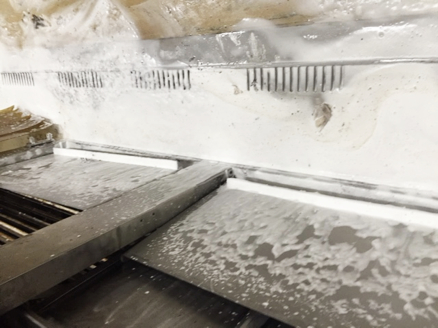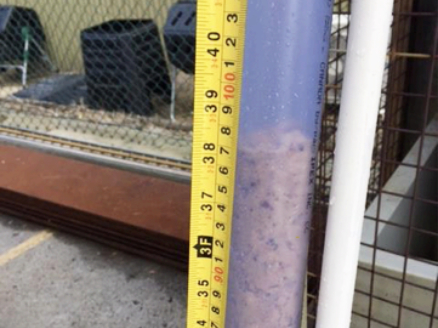Trial Objectives:
Positive Impact on control of Listeria: No indication of Listeria detected in trial period. We understand this is a significant improvement on the pre-trial period and demonstrates BioProtect™ Industrial Treatment’s positive impact on control of Listeria
Cost Efficacy: Identified $27k p.a. net cost savings through use of BioProtect™ Industrial Treatment through reduction of suspended solids, grease trap pump out frequency, chemical usage and improved discharge wastewater quality.
Background Information: Listeria Monocytogenes:
The facility processes meat products, predominantly bacons and hams and has ongoing issue with Listeria present in the drainage systems
- The presence of Listeria poses a significant risk to a business’s brand, management and financial performance.
- It has been documented that a recall of small goods by a South Australian company in 2005 because of contamination with L. monocytogenes cost around $2 million.
The following table shows the results of internal testing conducted in the facility specifically targeting Listeria, all results show negative with no Listeria detected.
Table: Weekly Detection Data
| Date (W/C) | Intensive Chiller 1 |
Intensive Chiller 2 |
Intensive Chiller 3 |
Intensive Chiller Drain |
Drain After Cook |
Bacon Chiller Walls |
Bacon Chiller Drains |
Dicing Chiller Walls |
Dicing Chiller Drains |
High Care Chiller Walls |
High Care Chiller Drains |
High Care Room Drains |
Dicing Room Drains |
Bacon Room Drains |
|---|---|---|---|---|---|---|---|---|---|---|---|---|---|---|
| 24/7/17 | N | N | N | N | N | N | N | N | N | N | N | N | N | N |
| 31/7/17 | N | N | N | N | N | N | N | N | N | N | N | N | N | N |
| 7/8/17 | N | N | N | N | N | N | N | N | N | N | N | N | N | N |
| 14/8/17 | N | N | N | N | N | N | N | N | N | N | N | N | N | N |
| 21/8/17 | N | N | N | N | N | N | N | N | N | N | N | N | N | N |
| 28/8/17 | N | N | N | N | N | N | N | N | N | N | N | N | N | N |
Value Proposition Enhancement:
The secondary objective was to prove the financial value proposition which hinges on the breakdown of organic material in the grease interceptor and the impact on the discharge wastewater and associated levies
- The majority of the meat that is processed is imported into Australia from North America or Europe, therefore the grease interceptor and trade waste is classified as quarantine material.
- The grease interceptor is pumped out on a monthly schedule @ $0.37 per litre, costing around $7,400 per month, by increasing the frequency between pump outs of the grease interceptor a substantial savings can be had.
Protocol:
- Grease interceptor was pumped out on 12th July 2017.
- Application started 20th July 2017, 7 production days after pump out.
- Application performed on the cooked side of the facility only and not on the uncooked side.
- Apply 10 litres of BioProtect™ Industrial treatment into every drain in the facility by foaming daily after the final wash down has been completed.
The Application:
10 litres of BioProtect™ Industrial Treatment was foamed into the drains daily after the final daily wash-down. This is the point where the flow through the drains and interceptor is at its lowest point which allows for the greatest residual time in the system. Maximising the length of time the product is in the drains and interceptor is important as it maximises the product’s impact. The cleaning staff reported that application of the product was a simple process and was completed in approximately 30 minutes.


Cost Assumptions:
- The cost has been worked on an average of 23 production days per month.
- BioProtect™ Industrial Treatment, 10 litres per day @ $9.00 per litre (transport included), $90 per day, $2,070 per month.
- Labour, 30 minutes per day @ $30 per hour, $15 per day, $345 per month.
- Total Cost $105 per day, $2,415 per month.
Saving Assumptions:
- Pump out cost of the grease interceptor $0.37 per litre for a 20,000-litre tank pumped monthly.
- Pump cost average at $322 per production day.
- Every day that the pump frequency is increased over 23 production days shows a cost savings of $322 less product and application costs.
Results:
Core sample taken 1st September 2017 (38 production days since last pumped) showing the solid loads in the grease interceptor, the first image shows the inlet chamber at 84% of its capacity, the second image is the outlet chamber at 75% of its capacity.
These results indicate that the interceptor is close to full and on the upper limits of its safe working capacity.


Sample Science Pty Ltd (the third-party testing company that conducted the testing) made the following observation “The bottom sludge layer is only ~50mm thick. This is unusual and probably means that much of the bottom layer is being pushed through the GT because the floating layer is overfull and so the water flow is pushing solids through the pit”. This observation could be considered differently, BioProtect™ is breaking down the sludge rather than pushing solids through the interceptor because if the solids were being pushed through the interceptor there would be an increase in the Total Suspended Solids (TSS) present in the outflow water which is not the case, in fact there is an overall average reduction of TSS of 44% as shown in the below table.
Table: 5-Day Composite Wastewater Test
| Test | Four Survey Average | August 17 Reading | Difference |
|---|---|---|---|
| BOD Kg | 3,249 | 2,693.30 | -17% |
| TSS Kg | 1,922 | 1,067.50 | -44% |
| TDS Kg | 4,633 | 4,332.60 | -7% |
| iTDS Kg | 2,886 | 2,553.10 | -12% |
| Chloride Kg | 1,445 | 1,190.40 | -18% |
| Sodium Kg | 1,227 | 964.2 | -24% |
| TKN Kg | 414 | 368.67 | -11% |
The above table shows the results of a 5-day composite wastewater test taken from the outlet side of the grease interceptor and compared against an average of 4 previous 5-day composite tests conducted. It is clear to see that there has been a good overall reduction in all the key parameters.
When extrapolated against levies imposed by South East water the following table shows these savings.
Table: Savings
| Test | Four Survey Average | August 17 Reading | Difference | Cost per Kg | Monthly Saving | |
|---|---|---|---|---|---|---|
| BOD Kg | 3249 | 2693.3 | -17% | $0.9199/kg | $511.19 | SE Water Charges |
| TSS Kg | 1922 | 1067.5 | -44% | $0.5158/kg | $440.75 | |
| TKN Kg | 414 | 368.67 | -11% | $2.0207/kg | $91.60 | |
| Hydrochloric Acid KG | 606 | 420 | -30% | -$0.74/kg | $137.64 | Chemicals used to balance PH |
| Sodium Hydroxide Kg | 630 | 285 | -55% | $0.98/kg | $338.10 | |
The above table shows the savings in waste water levies and chemicals used to balance the pH in the grease interceptor, showing an overall monthly savings of $1,519.28.
Summary:
The absence of Listeria over the extended period of the test compared to positive readings in previous periods showed that BioProtect™ had a positive impact on Listeria control.
The data indicates that the pump out frequency of the grease interceptor has been increased by at least 17 production days (74%), generating a $5,474 cost saving over a 40-day production cycle.
The test data demonstrates a SE water levies and pH adjustment chemicals saving of $2,642 over the 40-day cycle.
The cost of BioProtect™ Industrial Treatment including application labour was $4,200 over the 40-day production cycle.
Therefore, the test period data indicates, BioProtect™ Industrial Treatment has positively impacted Listeria control and generated $3,916 net cost saving per 40 production-day cycle ($27,248 pa).
Further Attributes:
It was noted during the trial phase that areas that have traditionally been hard to clean and remove the build-up of organic material, in particular the area where the cooked products are removed from the smoking oven are much cleaner displaying the detergent qualities of the product.